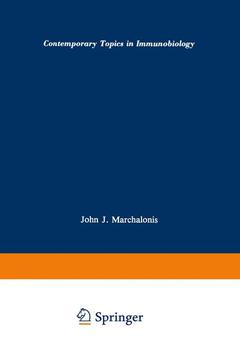Description
Immunobiology of Parasites and Parasitic Infections, Softcover reprint of the original 1st ed. 1984
Contemporary topics in immunobiology Series, Vol. 12
Language: English
Subjects for Immunobiology of Parasites and Parasitic Infections:
Keywords
DNA; antibody; antigen; biochemistry; biology; diseases; immunobiology; infection; infections; malaria; molecular biology; parasite; protozoa; resistance; vaccine
Publication date: 09-2013
497 p. · 17.8x25.4 cm · Paperback
497 p. · 17.8x25.4 cm · Paperback
Description
/li>Contents
/li>
The phenomena involved in infections of man and domestic animals with metazoan or protozoan parasites present formidable practical problems as well as a theoretical challenge to immunologists, molecular biologists, and evolu tionary biologists. With respect to the public health and economic problems, malaria, for example, remains a major health problem with approximately 200 million people being infected yearly and, on the basis of World Health Organiza tion estimates, more than 1 million children die each year of malaria infections (Chapter 4). This volume addresses state-of-the-art immunologic approaches to the development of vaccines for parasitic diseases (Chapter 9) and analyses of studies bearing on the antigenic characterization of protozoan and metazoan parasites (Chapters 4, 5, and 7), on investigations of the role of precise mecha nisms underlying natural resistance or non permissiveness of the host to parasitic infections (Chapters 1, 2, and 12), on induced mechanisms including the genera tion of parasite-specific T-cell lines and clones (Chapter 6), and on the generation of monoclonal antibodies (Chapters 4 and 5) to parasite antigens of distinct de velopmental stages. Great progress has been made in characterizing parasite antigens capable of inducing a protective response in the vaccinated host; further progress in this area strongly depends on biochemistry and molecular biology with the long-term goal of synthesizing such antigens chemically or producing them by means of recombinant DNA technology (Chapter 4).
1 Natural Resistance to Animal Parasites.- I. Introduction.- II. Natural Resistance in Vertebrate Hosts.- III. Mechanisms of Natural Resistance.- IV. Conclusions.- V. References.- 2 Intracellular Mechanisms of Killing.- I. Introduction.- II. Parasite Interiorization by Mononuclear Phagocytes.- III. Trypanosoma cruzi: Macrophage Activation and Intracellular Killing.- IV. Toxoplasma gondii: Macrophage Activation and Intracellular Killing.- V. Leishmania spp.: Macrophage Activation and Intracellular Killing.- VI. Conclusions.- VII. References.- 3 Induction and Expression of Mucosal Immune Responses and Inflammation to Parasitic Infections.- I. Introduction.- II. The Interface: Host Cells Meet Parasite Antigens.- III. Immune Responses and Mucosal Inflammation in Parasitic Infections.- IV. Mucosal Effectors of Host Resistance.- V. Conclusions.- VI. References.- 4 Antigenic Characterization of Plasmodia.- I. Introduction.- II. Plasmodial Life Cycle.- III. Sporozoites.- IV. Exoerythrocytic Stages.- V. Asexual Erythrocytic Stages.- VI. Gametes.- VII. Conclusions and Prospects.- VIII. References.- 5 Roles of Surface Antigens on Malaria-Infected Red Blood Cells in Evasion of Immunity.- I. Introduction.- II. Immunity to Asexual Malaria Parasites.- III. Antigens on Malaria-Infected Erythrocytes—Targets of Parasiticidal Immunity?.- IV. Nature of New Antigens on Infected Cells.- V. Parasitic Evasion of Immunity—General Concepts.- VI. SICA Antigen-Immune Evasion.- VII. Knobs and Immune Evasion by Sequestration.- VIII. Concluding Remarks.- IX. References.- 6 Murine T-Cell Responses to Protozoan and Metazoan Parasites: Functional Analysis of T-Cell Lines and Clones Specific for Leishmania tropica and Schistosoma mansoni.- I. Leishmania tropica Major.- II. Schistosoma mansoni.- III.References.- 7 Immunobiology of African Trypanosomiasis.- I. Introduction.- II. Trypanosome Antigens.- III. Protective Immune Response.- IV. Deleterious Effects of the Immune Response.- V. Effects of Trypanosome Infection on the Lymphoid System.- VI. Susceptibility to Trypanosomiasis.- VII. Conclusions.- VIII. References.- 8 Rodent Models of Filariasis.- I. Introduction.- II. Responses of the Host to Developing Larvae and Adult Worms.- III. Responses of the Host to Microfilariae.- IV. Conclusions.- V. References.- 9 Examination of Strategies for Vaccination against Parasitic Infection or Disease Using Mouse Models.- I. Introduction.- II. Taenia taeniaeformis (Murine Cysticercosis): Immunoprophylaxis and Immunotherapy.- III. Leishmania tropica (Murine Cutaneous Leishmaniasis): Vaccination against Parasite Establishment or Chronic Disease.- IV. Schistosoma japonicum (Murine Schistosomiasis Japonica): Vaccination against Immunopathologic Disease.- V. Giardia muris (Murine Giardiasis): Vaccination for Accelerated Rejection of Intestinal Parasites.- VI. Nematospiroides dubius (Murine Nematodiasis): Vaccination for Accelerated Rejection of Intestinal Parasites.- VII. Fasciola hepatica (Murine Fascioliasis): Vaccination for Neutralization of Parasite-Protective Mechanisms.- VIII. Concluding Comments.- IX. References.- 10 Immunity in Schistosomiasis: A Holistic View.- I. Introduction.- II. Host Quality and Immunity.- III. Immunogenic Stages.- IV. Vulnerable Stages.- V. Dose and Time Effects in Induction of Immunity.- VI. Influences of Host and Parasite Quality on Effective Antigenic Load.- VII. Interaction of Effective Antigenic Load and Host Genotype in Induction of Immunity.- VIII. Dual-Immunity Theories in Schistosomiasis.- IX. Connections Between Acquired Resistance and Egg-Induced Hypersensitivity.- X. Concluding Remarks.- XI. References.- 11 Immunopathology of Parasitic Diseases: A Conceptual Approach.- I. Introduction.- II. Filariasis.- III. Schistosomiasis.- IV. Summary.- V. References.- 12 Cellular Immunity to Malaria and Babesia Parasites: A Personal Viewpoint.- I. Introduction.- II. Relationship of the Sickle Cell Trait to Malaria.- III. Malaria and Glucose 6-Phosphate Dehydrogenase Deficiency.- IV. Synergistic Effects of Inherited and Acquired Immunity to Malaria.- V. Role of Cell-Mediated Immunity in Malaria and Babesiosis.- VI. Nonspecific Immunity to Hemoprotozoan Infections.- VII. Antibody Independence of Immunity to Hemoprotozoa.- VIII. Multiplication of P. falciparum in Cultures of Erythrocytes with Abnormal Hbs and G6PD Deficiency.- IX. Susceptibility of Erythrocytes to Oxidant Stress.- X. Factors That Increase and Decrease Susceptibility of Erythrocytes to Oxidant Stress.- XI. Production of Superoxide and Hydrogen Peroxide by Leukocytes.- XII. Oxidant Stress Exerted on Erythrocytes by Malaria Parasites.- XIII. Effects of Oxidants on Malaria Parasites in Erythrocytes.- XIV. Tumor-Necrosis Factor, Lipoproteins, and Oxidized Lipids.- XV. Cell-Mediated Immunity and Premunition.- XVI. Synergism of Cell-Mediated Immunity and Inherited Erythrocytic Resistance.- XVII. Controversy and the Development of Science.- XVIII. References.
© 2024 LAVOISIER S.A.S.
These books may interest you

Toxoplasma gondii 52.74 €


